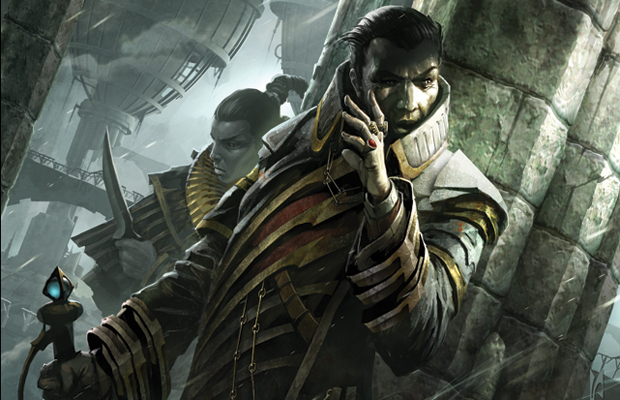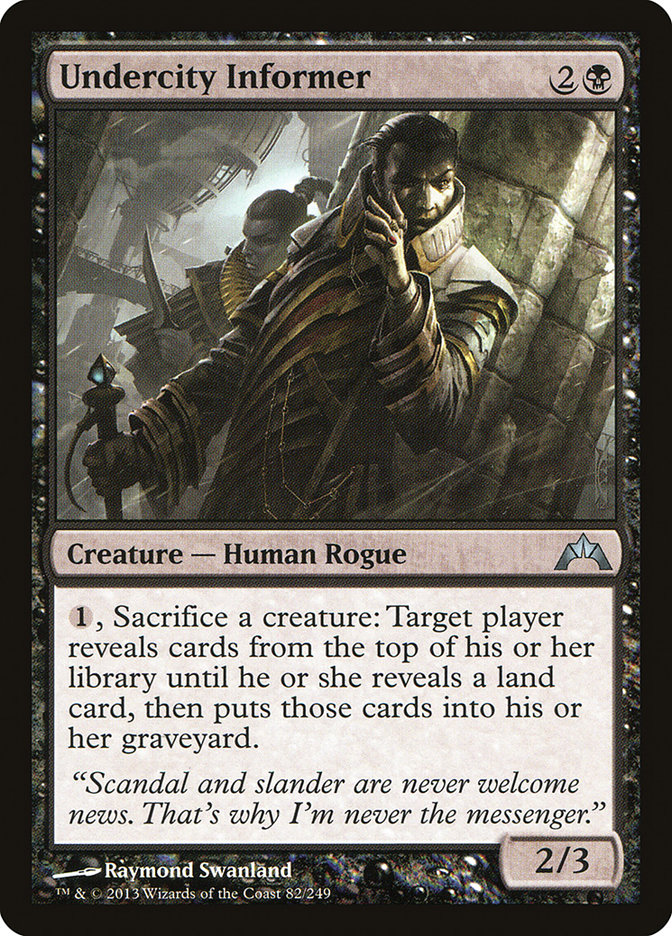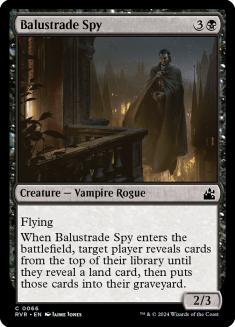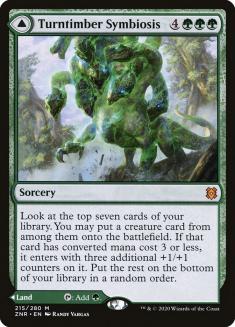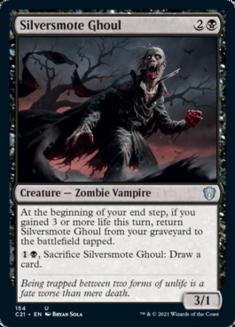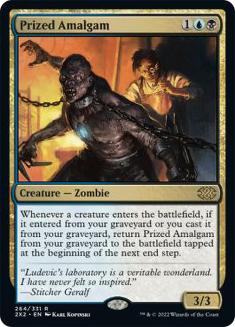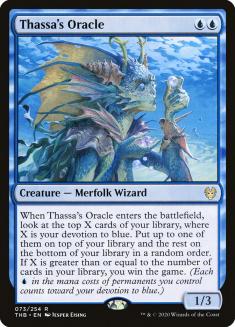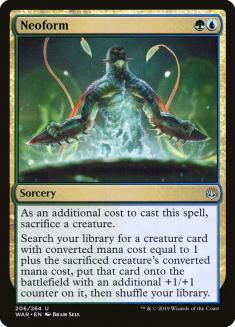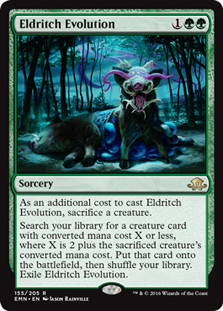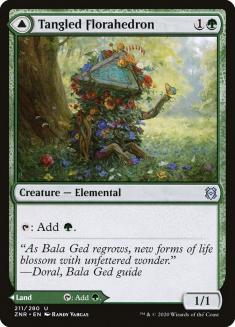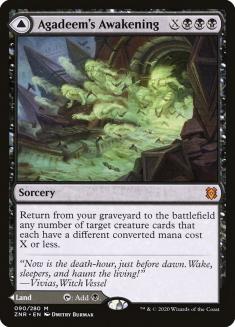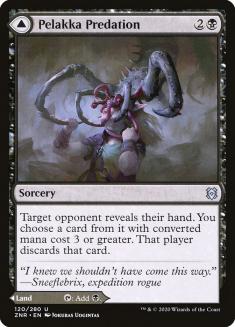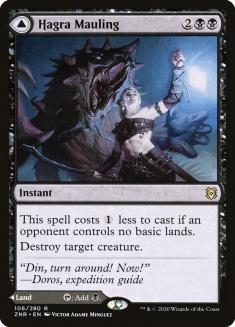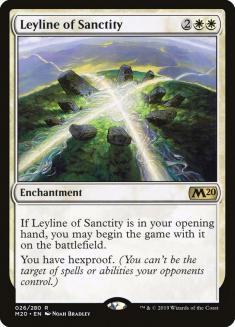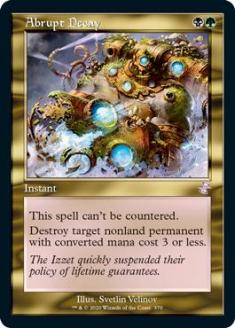Something very weird is happening right now…
Gatecrash unleashed a bizarre new breed of combo deck on Legacy, using the format’s vast array of cheap acceleration and artifact mana to cast Balustrade Spy or Undercity Informer with zero lands in the deck and converting that into a win via Narcomoeba plus Dread Return. This was theoretically possible in any format where these spy kids were legal and there were always innovative workarounds for the lack of Dread Return — the most recent Modern iteration wins through an absurdly elaborate sequence involving Narcomoeba, Sword of the Meek, Salvage Titan, and Vengevine!
However, getting off the ground without the likes of Lotus Petal and Dark Ritual was impossible and Magic designers over the years have been burned by those effects too many times to try them again. Oops All Spells seemed destined to remain an obscure gimmick in competitive Magic’s oldest format.
Zendikar Rising changed all that:
These modal double-faced cards (DFCs) offer a revealing test of how you approach the game. Do you think of the implications for Limited, where you have to grudgingly keep fewer two-land or five-land hands? Maybe you realize that attaching extra sources of a colour to playable spells mitigates the lack of mana fixing for aggressive decks in Zendikar Rising Standard. If you’re like me, you have immediate visions of flipping your entire deck in one exaggerated motion as Magic Online forces the opponent to acknowledge their impending doom:
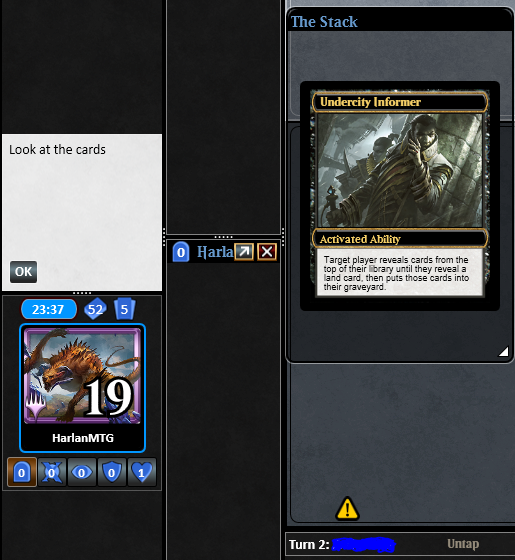
This accounting quirk allows you to make regular land drops without violating the deckbuilding demands of Goblin Charbelcher or its Roguish cousins. These ‘lands’ gave Legacy Oops All Spells some crucial stability, elevating it to a format mainstay. In Modern, these lands get you to slower ramp like Pentad Prism or Talismans that bridges the gap to Balustrade Spy. In Pioneer, just making your land drops and casting Informer or Spy on-curve is fast enough to race most of the format. We then need to win somehow:
Milling a set of Creeping Chills not only undoes all of an aggro deck’s hard work but triggers Silversmote Ghoul, which in turn brings back a set of Prized Amalgams. A pair of Worldspine Wurms shuffle themselves back into your empty library to give you the combat phases needed to finish the job, while Haunted Dead can discard Wurms to refresh that timer or rebuy Amalgams against a sweeper. Narcomoeba is often seen as a sideboard card that allows this chain to happen against Roiling Vortex.
Building a large battlefield without haste isn’t enough in many situations. Decks like Lotus Field Combo or Temur Reclamation can stop you ever getting to untap. Selesnya or Orzhov Auras can stitch together a large lifelink creature to hold off the Zombie horde, while popular sweepers like Anger of the Gods or Shadows’ Verdict out of Five-Colour Niv-Mizzet – which effectively runs five copies thanks to Bring to Light – can deal with it permanently. Many lists adopted Thassa’s Oracle as a backup plan for this reason:
Creatures (22)
Spells (38)
- 4 Claim
- 4 Creeping Chill
- 4 Pelakka Predation
- 4 Sea Gate Restoration
- 2 Shatterskull Smashing
- 4 Jwari Disruption
- 4 Silundi Vision
- 4 Hagra Mauling
- 4 Agadeem's Awakening
- 4 Beyeen Veil
Sideboard

This list can build its own Inverter of Truth with Informer or Spy and use Thassa’s Oracle to win outside of combat. Claim // Fame can return Oracle cheaply on the combo turn and the actual text on Agadeem’s Awakening can become relevant here with enough time and mana; Revival // Revenge is a more expensive option that can bring back a countered or discarded Undercity Informer. In the green-heavy lists, Bala Ged Recovery can rebuy Thassa’s Oracle to similar effect.
This function of Thassa’s Oracle could be accomplished with just a single copy in the deck but it also serves a useful role against graveyard hate. With no other deck relying enough on the graveyard to justify hate, early lists hoping to catch the metagame off-guard had less reason to lean hard on Oracle. Now that Oops is posting high-profile finishes in Pioneer, savvy or scared opponents are sure to show up with Soul-Guide Lantern or similar hate and a card that speeds up your regular wins and acts as an alternate win condition looks very appealing.
In explaining the resurgence of Lotus Field Combo I argued that the removal of multifaceted decks like Dimir Inverter opened more room for linear decks that demanded narrow answers, shrinking the target on any one linear deck as sideboard slots were stretched thin. Oops All Spells fits neatly in that equation; every Damping Sphere is a blank square that could be a Tormod’s Crypt. Present-day Pioneer is far from the combo-free oasis imagined by the last round of bans — if anything, it resembles previous iterations of Modern in that choosing the linear deck that nobody is targeting while aiming for the others yourself is a recipe for success. With that in mind, the utility of Thassa’s Oracle may vary with Oops’s recent success or popularity; if graveyard hate is ubiquitous such that Oracle is important, that may be a sign to look elsewhere unless you think Oops is well-positioned otherwise.
Only black is a locked-in colour for Oops, with the others all offering something (except white, naturally). Consider this highly interactive Rakdos list:
Creatures (23)
Spells (37)
- 4 Thoughtseize
- 4 Collective Brutality
- 1 Driven
- 4 Creeping Chill
- 4 Valakut Awakening
- 4 Pelakka Predation
- 4 Spikefield Hazard
- 4 Shatterskull Smashing
- 4 Hagra Mauling
- 4 Agadeem's Awakening
Sideboard

Between Thoughtseize, Collective Brutality, and Pelakka Predation, this list can clear the way for its combo very effectively and obstruct other linear decks hoping to race you. Collective Brutality in particular is a great pickup against Boros Wizards, the talk of the town after several strong finishes including a Magic Online Super Qualifier win by our own Cedric Phillips, and is easy to escalate with dead or redundant combo pieces. Spikefield Hazard can snipe an Elvish Mystic or Bloodsoaked Champion while Shatterskull Smashing is the most realistically castable of the mythic cycle of untapped double-faced cards.
The sideboard shows why black is the best colour for interaction in Pioneer — Duress as even more discard, Fatal Push and Bloodchief’s Thirst as hyper-efficient removal, and Feed the Swarm as a unique answer to Leyline of the Void or Rest in Peace. Necromentia has incredibly high upside as a one-card instant win against Lotus Field Combo or the mirror (hitting Worldspine Wurm against non-Oracle lists to prevent them having another turn to enter combat), which highlights the importance of backup plans like Thassa’s Oracle if other decks try the same tactic. The best selling point for red is found in the maindeck; Valakut Awakening lets you reroll your whole hand in search of Spy or Informer while tucking Creeping Chills that want to be in your library and the motley crew of creatures required as a win condition.
It would be easy to brush off these League results as the usual nonsense that you see when a new set is released. A shocking win last month made Oops hard to ignore:
Creatures (35)
Spells (45)
- 4 Thoughtseize
- 4 Eldritch Evolution
- 3 Collective Brutality
- 1 Driven
- 4 Creeping Chill
- 3 Neoform
- 3 Pelakka Predation
- 4 Bala Ged Recovery
- 4 Sea Gate Restoration
- 4 Hagra Mauling
- 4 Turntimber Symbiosis
- 4 Agadeem's Awakening
- 3 Vastwood Fortification
Sideboard

It’s a sign of the times that we’re used to seeing 80-card decks without batting an eyelid. The biggest surprise is the lack of the biggest bird — Yorion, Sky Nomad is the go-to reason for a larger deck, but that isn’t present here and wouldn’t do anything if it were! SanPop claimed that they wanted to try a non-Yorion 80-card version as a joke and they certainly had the last laugh, though you may want Yorion as a companion now not to give the game away instantly…
This result should be impossible on paper. The 80-card decks of the past exploited the redundancy on basic effects in their format as well as their own flexibility and lack of demand for specific cards. The rare ‘exceptions’ were combo-control decks like Dimir Inverter here or Scapeshift in Modern that could easily win without their namesakes especially with Yorion’s help. Oops All Spells is a dedicated combo deck with highly restrictive deckbuilding requirements that needs to resolve Balustrade Spy or Undercity Informer every game. How can it support itself with 80 cards?
The answer lies in this list’s more serious innovation: Neoform and Eldritch Evolution. If these are counted as virtual copies of Informer or Spy, SanPop’s list has fifteen combo pieces in an 80-card deck versus eight in a 60-card deck — a ratio that substantially favours SanPop. They both shave mana off the kill compared to hardcasting Spy or Informer and offer another degree of flexibility; finding Balustrade Spy consistently if Informer is off-limits thanks to Pithing Needle, for example.
These new additions aren’t free; they require sacrificial fodder and a manabase that can cast them consistently. Addressing the first problem helps with the second — the ideal subjects for Neoform or Eldritch Evolution are resilient mana creatures like Paradise Druid or Sylvan Caryatid that add the missing colour — but deck space remains a concern. Once we account for Spy and Informer, some number of Neoform and Evolution as well as enough mana creatures for them, the dozen or more cards needed to win the game when we bin our deck, and enough double-faced cards to cast our spells, we quickly run out of room even with workhorses like Tangled Florahedron satisfying multiple requirements. Going above 60 here is a question forced upon us, not one we choose to engage with.
This isn’t a binary choice between 60 and 80 cards; all else being equal, it would be a surprise for exactly 80 cards to be the right choice and there are templates for how to accomplish these goals with a lower card count.
Creatures (35)
Spells (42)

LucasG1ggs’s 77-card list shows how you can trim the fat from the starting 80 and we can continue down that path. We don’t need the fourth Silversmote Ghoul, but do we actually need the second Haunted Dead? How much does the manabase suffer without that Vastwood Fortification?
Creatures (30)
Spells (33)

Notorious mad genius __matsugan (Atsushi Ito) may have found a way to square the circle. His 63-card list trims the central combo cards in Spy and Informer to put the focus squarely on Neoform and Eldritch Evolution, a choice that makes sense in a smaller deck where we have our mana creature on Turn 2 more often. He also gets to run a minimalist sideboard toolbox — Reclamation Sage and Skyclave Apparition against hateful permanents and Archon of Emeria as hate for Lotus Field Combo.
There’s a lot of space to explore in the middle. Could we run more Informers and Spies while staying below 70 cards, maximizing our access to the combo while minimizing the cost? Is the third Silversmote Ghoul all that important, especially with Driven // Despair to force our attackers through?
This discussion shouldn’t ignore the sacrifices that come with extra cards, both those specific to this deck and the general ones that made 60 or 40 or whatever the minimum deck size is in a format a firm default:
Though even the worst DFCs get a chance to shine here, not all of them are created equal. Lands entering the battlefield tapped is a severe drawback that compounds itself the more you have to run, making curving properly very difficult — you can definitely afford a tapped land on Turn 1, can possibly afford it on Turn 2 where you’d rather be casting a mana creature, and absolutely can’t afford it when you need that fourth mana on your combo turn. There’s a theoretical cap of twenty DFCs that enter untapped but most of these are guaranteed to be off-colour no matter what colour combination you choose — Emeria, Shattered Skyclave can’t cast Paradise Druid or the follow-up Neoform. Without the colour-agnostic Modern fixing like Talismans or Pentad Prism, you have to make careful tradeoffs between tapped, on-colour lands and untapped, off-colour lands. As your deck size increases, your odds of drawing the ideal untapped, on-colour land get worse.
Bloating the deck is only justifiable when our access to combo pieces scales at a faster rate. There are other types of card — sideboard hammers like Leylines or anti-hate measures like Abrupt Decay — where that redundancy is either impossible or requires a greater commitment to valuable slots.
This suggests another unexplored tactic: registering more than 60 cards in the maindeck and fewer than 15 in the sideboard. If you decide that you want both maindeck Thoughtseize and the ability to shed those when they aren’t important, that may be worth losing those sideboard slots. Alternatively, if you know that one attack will always be enough to kill in the matchup, you can cut the second Worldspine Wurm (or maybe even the second Silversmote Ghoul?!) without needing to replace it.
Oops All Spells has broken barriers in Magic deckbuilding that stood for over a quarter of a century. It may also be the best deck in Pioneer — if not in the abstract, at least when people forget about it this week. If you want to win a lot and do it in unrivalled style, this is the deck for you.

